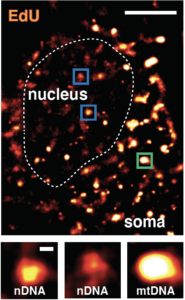In neurons, DNA damage may occur at any time and at any genomic site. So, you might think that over time, DNA repairs would occur throughout the genome on a random basis. Wrong! According to a new study by Salk scientists, some genomic sites are privileged. Always at the head of the line for repairs, these genomic sites—or “hot spots”—appear to play a critical role in neural identity and function. Moreover, these sites, these DNA repair hot spots (DRHs), are associated with aging and neurodegenerative disease. DRHs, then, may point to new therapies for diseases such Alzheimer’s, Parkinson’s, and other age-related dementia disorders.
The Salk scientists presented their findings April 2 in Science, in an article titled, “Incorporation of a nucleoside analog maps genome repair sites in postmitotic human neurons.” The article emphasizes that identifying DRHs depends on looking for instances of repair, rather than performing the more usual activity, that is, looking for instances of damage. To flip the script in this way, the Salk scientists had to develop a new technique, Repair-seq.
“To better understand genome integrity in neurons, we developed a sequencing method capable of capturing a genomic distribution of all DNA repair by the nonreplicative incorporation of the nucleoside analog 5-ethynyl-2ʹ-deoxyuridine (EdU),” the article’s authors wrote. “We generated human embryonic stem cell–induced neurons (ESC-iNs) that assume a postmitotic neuron identity after the addition of doxycycline through NEUROG2 expression. ESC-iNs were labeled with EdU for 24 hours, and sites of DNA repair synthesis were identified by the enrichment of next-generation sequencing libraries containing EdU.”
Using Repair-seq, the authors found approximately 65,000 hot spots that covered around 2% of the neuronal genome. They then used proteomics approaches to detect what proteins were found at these hot spots, implicating many splicing-related proteins. Many of these sites appeared to be quite stable when the cells were treated with DNA-damaging agents, and the most stable DRHs were found to be strongly associated with sites associated with the epigenetic clock and genomic evolutionary rate profiling–defined constrained elements.

Unlike other cells, neurons generally don’t replace themselves over time, making them among the longest-living cells in the human body. Their longevity makes it even more important that they repair lesions in their DNA as they age, in order to maintain their function over the decades of a human life span. As they get older, neurons’ ability to make these genetic repairs declines, which could explain why people develop age-related neurodegenerative diseases like Alzheimer’s and Parkinson’s.
Although the scientists expected to see some prioritization in DNA repair, they were surprised by just how focused the neurons were on protecting certain sections of the genome.
“What we saw was incredibly sharp, well-defined regions of repair; very focused areas that were substantially higher than background levels,” said co-first and co-corresponding author Dylan Reid, PhD, a former Salk postdoctoral scholar and now a fellow at Vertex Pharmaceutics. “The proteins that sit on these ‘hot spots’ are implicated in neurodegenerative disease, and the sites are also linked to aging.”
Previous research has focused on identifying the sections of DNA that suffer genetic damage, but this is the first time researchers have looked for where the genome is being heavily repaired.
“We flipped the paradigm from looking for damage to looking for repair, and that’s why we were able to find these hot spots,” Reid remarked. “This is really new biology that might eventually change how we understand neurons in the nervous system, and the more we understand that, the more we can look to develop therapies addressing age-related diseases.”
“This research shows for the first time that there are sections of genome that neurons prioritize when it comes to repair,” asserted Rusty Gage, PhD, the paper’s co-corresponding author, president of the Salk Institute for Biological Studies. “We’re excited about the potential of these findings to change the way we view many age-related diseases of the nervous system and potentially explore DNA repair as a therapeutic approach.”
Gage, who holds the Vi and John Adler chair for research on age-related neurodegenerative disease, added, “Understanding which areas within the genome are vulnerable to damage is a very exciting topic for our lab. We think Repair-seq will be a powerful tool for research, and we continue to explore additional new methods to study genome integrity, particularly in relation to aging and disease.”







